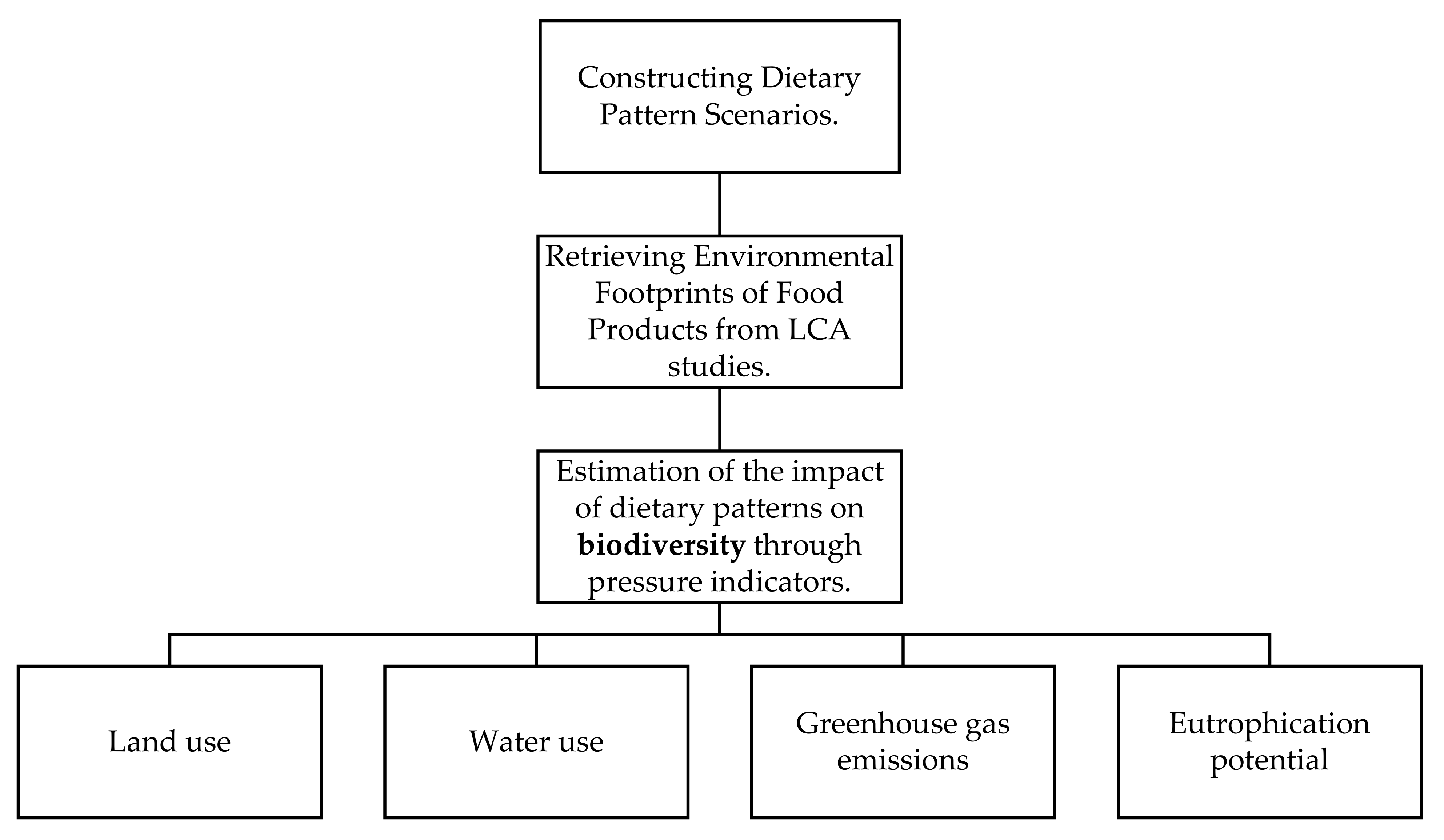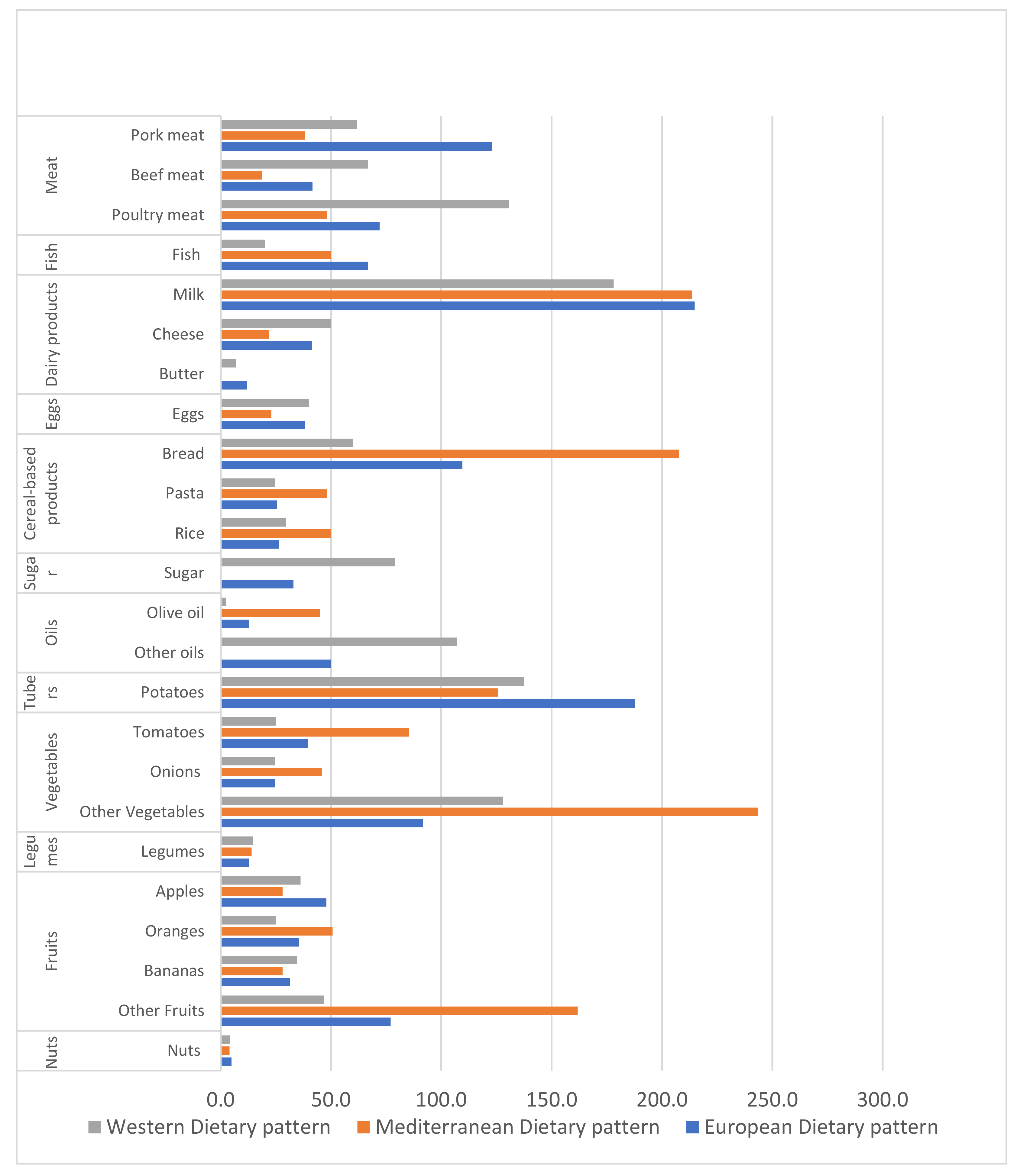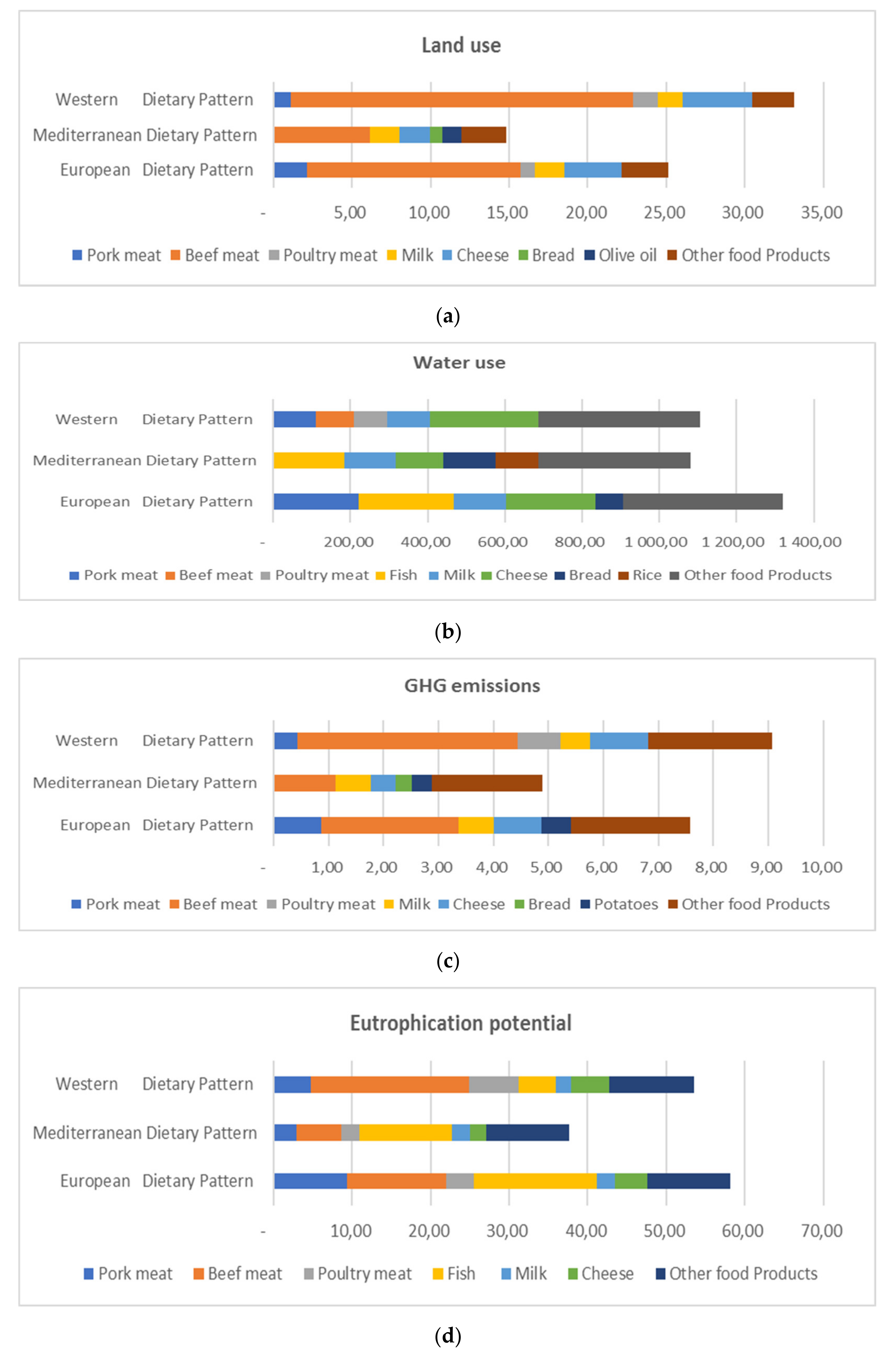Changing Dietary Behavior for Better Biodiversity Preservation: A Preliminary Study
Abstract
1. Introduction
2. Materials and Methods
2.1. Dietary Composition Scenarios
2.2. Environmental Footprints
3. Results
4. Discussion
5. Conclusions
Author Contributions
Funding
Conflicts of Interest
References
- Leclere, D.; Obersteiner, M.; Alkemade, R.; Almond, R.; Barrett, M.; Bunting, G.; Young, L. Towards Pathways Bending the Curve Terrestrial Biodiversity Trends within the 21st Century; IIASA: Laxenburg, Austria, 2018. [Google Scholar]
- Hoepfl, K.P. Conceptualising Ecological Sustainability: Issues, Values and Challenges. Ph.D. Thesis, Stellenbosch University, Stellenbosch, South Africa, 2019. [Google Scholar]
- Brockerhoff, E.G.; Barbaro, L.; Castagneyrol, B.; Forrester, D.I.; Gardiner, B.; González-Olabarria, J.R.; Lyver, P.O.; Meurisse, N.; Oxbrough, A.; Taki, H.; et al. Forest biodiversity, ecosystem functioning and the provision of ecosystem services. Biodivers. Conserv. 2017, 26, 3005–3035. [Google Scholar] [CrossRef]
- Mori, A.S. Advancing nature-based approaches to address the biodiversity and climate emergency. Ecol. Lett. 2020, 23, 1729–1732. [Google Scholar] [CrossRef]
- Isbell, F.; Craven, D.; Connolly, J.; Loreau, M.; Schmid, B.; Beierkuhnlein, C.; Bezemer, T.M.; Bonin, C.; Bruelheide, H.; de Luca, E.; et al. Biodiversity increases the resistance of ecosystem productivity to climate extremes. Nat. Cell Biol. 2015, 526, 574–577. [Google Scholar] [CrossRef]
- Secretary of the Convention on Biological Diversity (SCBD); Global Biodiversity Outlook 4: Montreal, QC, Canada, 2014.
- Convention on Biological Diversity. 2014. Available online: www.cbd.int/ (accessed on 4 December 2020).
- Biosafety. The Convention on Biological Diversity. Convention on Biological Diversity, Secretariat of the Convention on Biological Diversity. Available online: www.CBD.int/convention/ (accessed on 4 December 2020).
- Atkins, J.P.; Burdon, D.; Elliott, M.; Gregory, A.J. Management of the marine environment: Integrating ecosystem services and societal benefits with the DPSIR framework in a systems approach. Mar. Pollut. Bull. 2011, 62, 215–226. [Google Scholar] [CrossRef]
- Dudley, N.; Alexander, S. Agriculture and biodiversity: A review. Biodiversity 2017, 18, 45–49. [Google Scholar] [CrossRef]
- Crist, E.; Mora, C.; Engelman, R. The interaction of human population, food production, and biodiversity protection. Science 2017, 356, 260–264. [Google Scholar] [CrossRef] [PubMed]
- Dalin, C.; Outhwaite, C.L. Impacts of Global Food Systems on Biodiversity and Water: The Vision of Two Reports and Future Aims. One Earth 2019, 1, 298–302. [Google Scholar] [CrossRef]
- Sala, S.; McLaren, S.J.; Notarnicola, B.; Saouter, E.; Sonesson, U. In quest of reducing the environmental impacts of food production and consumption. J. Clean. Prod. 2017, 140, 387–398. [Google Scholar] [CrossRef]
- Kanianska, R. Agriculture and its impact on land-use, environment, and ecosystem services. In Landscape Ecology—The Influences of Land Use and Anthropogenic Impacts of Landscape Creation; InTech: Rijeka, Croatia, 2016; pp. 1–26. [Google Scholar]
- Stevanović, M.; Popp, A.; Bodirsky, B.L.; Humpenöder, F.; Müller, C.; Weindl, I.; Dietrich, J.P.; Lotze-Campen, H.; Kreidenweis, U.; Rolinski, S.; et al. Mitigation Strategies for Greenhouse Gas Emissions from Agriculture and Land-Use Change: Consequences for Food Prices. Environ. Sci. Technol. 2016, 51, 365–374. [Google Scholar] [CrossRef]
- GRAIN & IATP, 2018. Emissions Impossible: How Big Meat and Dairy are Heating up the Planet. Available online: https://www.grain.org/article/entries/5976-emissions-impossible-how-big-meat-and-dairy-areheating-up-the-planet (accessed on 8 November 2020).
- Fact2: Agricultural Use. United Nations Educational, Scientific and Cultural Organization. 2021. Available online: http://www.unesco.org/new/en/natural-sciences/environment/water/wwap/facts-and-figures/all-facts-wwdr3/fact2-agricultural-use/ (accessed on 16 October 2020).
- Onofrei, M.; Vintila, G.; Dascalu, E.D.; Roman, A.; Firtescu, B.-N. The Impact of Environmental Tax Reform On Greenhouse Gas Emissions: Empirical Evidence From European Countries. Environ. Eng. Manag. J. 2017, 16, 2843–2849. [Google Scholar] [CrossRef]
- Aleksandrowicz, L.; Green, R.; Joy, E.J.M.; Smith, P.; Haines, A. The Impacts of Dietary Change on Greenhouse Gas Emissions, Land Use, Water Use, and Health: A Systematic Review. PLoS ONE 2016, 11, e0165797. [Google Scholar] [CrossRef] [PubMed]
- Poore, J.; Nemecek, T. Reducing food’s environmental impacts through producers and consumers. Science 2018, 360, 987–992. [Google Scholar] [CrossRef]
- Caro, D.; Pulselli, F.M.; Borghesi, S.; Bastianoni, S. Mapping the international flows of GHG emissions within a more feasible consumption-based framework. J. Clean. Prod. 2017, 147, 142–151. [Google Scholar] [CrossRef]
- Hu, W.; Li, C.-H.; Ye, C.; Wang, J.; Wei, W.-W.; Deng, Y. Research progress on ecological models in the field of water eutrophication: CiteSpace analysis based on data from the ISI web of science database. Ecol. Model. 2019, 410, 108779. [Google Scholar] [CrossRef]
- Glibert, P.M.; Seitzinger, S.; Heil, C.A.; Burkholder, J.M.; Parrow, M.W.; Codispoti, L.A.; Kelly, V. Eutrophication. Oceanography 2005, 18, 198. [Google Scholar] [CrossRef]
- Le Moal, M.; Gascuel-Odoux, C.; Ménesguen, A.; Souchon, Y.; Étrillard, C.; Levain, A.; Moatar, F.; Pannard, A.; Souchu, P.; Lefebvre, A.; et al. Eutrophication: A new wine in an old bottle? Sci. Total Environ. 2019, 651, 1–11. [Google Scholar] [CrossRef] [PubMed]
- Hamilton, H.A.; Ivanova, D.; Stadler, K.; Merciai, S.; Schmidt, J.; van Zelm, R.; Moran, D.; Wood, R. Trade and the role of non-food commodities for global eutrophication. Nat. Sustain. 2018, 1, 314–321. [Google Scholar] [CrossRef]
- Jay, J.A.; D’Auria, R.; Nordby, J.C.; Rice, D.A.; Cleveland, D.A.; Friscia, A.; Kissinger, S.; Levis, M.; Malan, H.; Rajagopal, D.; et al. Reduction of the carbon footprint of college freshman diets after a food-based environmental science course. Clim. Chang. 2019, 154, 547–564. [Google Scholar] [CrossRef]
- Dernini, S.; Berry, E.; Serra-Majem, L.; La Vecchia, C.; Capone, R.; Medina, F.; Aranceta-Bartrina, J.; Belahsen, R.; Burlingame, B.; Calabrese, G.; et al. Med Diet 4.0: The Mediterranean diet with four sustainable benefits. Public Health Nutr. 2016, 20, 1322–1330. [Google Scholar] [CrossRef]
- Seconda, L.; Baudry, J.; Allès, B.; Hamza, O.; Boizot-Szantai, C.; Soler, L.-G.; Galan, P.; Hercberg, S.; Lairon, D.; Kesse-Guyot, E. Assessment of the Sustainability of the Mediterranean Diet Combined with Organic Food Consumption: An Individual Behaviour Approach. Nutrients 2017, 9, 61. [Google Scholar] [CrossRef]
- Mazzocchi, A.; Leone, L.; Agostoni, C.; Pali-Schöll, I. The secrets of the Mediterranean diet. Does [only] olive oil matter? Nutrients 2019, 11, 2941. [Google Scholar] [CrossRef] [PubMed]
- Martinez, M.; Tena, A. The Mediterranean Diet. 2021. Available online: http://www.unesco.org/archives/multimedia/document-1680-eng-2 (accessed on 16 December 2020).
- Radd-Vagenas, S.; Kouris-Blazos, A.; Singh, M.F.; Flood, V.M. Evolution of Mediterranean diets and cuisine: Concepts and definitions. Asia Pac. J. Clin. Nutr. 2017, 26, 749–763. [Google Scholar]
- Guilleminault, L.; Williams, E.J.; Scott, H.A.; Berthon, B.S.; Jensen, M.; Wood, L.G. Diet and Asthma: Is It Time to Adapt Our Message? Nutrients 2017, 9, 1227. [Google Scholar] [CrossRef]
- Last, A.R.; Wilson, S.F. Low-carbohydrate diets. Am. Fam. Physician 2006, 73, 1942–1948. [Google Scholar]
- Stevenson, R.J.; Francis, H.M.; Attuquayefio, T.; Gupta, D.; Yeomans, M.R.; Oaten, M.J.; Davidson, T. Hippocampal-dependent appetitive control is impaired by experimental exposure to a Western-style diet. R. Soc. Open Sci. 2020, 7, 191338. [Google Scholar] [CrossRef]
- Boylan, S.; Welch, A.; Pikhart, H.; Malyutina, S.; Pajak, A.; Kubinova, R.; Bragina, O.; Simonova, G.; Stepaniak, U.; Gilis-Januszewska, A.; et al. Dietary habits in three Central and Eastern European countries: The HAPIEE study. BMC Public Health 2009, 9, 439. [Google Scholar] [CrossRef] [PubMed]
- Boylan, S.; Lallukka, T.; Lahelma, E.; Pikhart, H.; Malyutina, S.; Pajak, A.; Kubinova, R.; Bragina, O.; Stepaniak, U.; Gillis-Januszewska, A.; et al. Socio-economic circumstances and food habits in Eastern, Central and Western European populations. Public Health Nutr. 2010, 14, 678–687. [Google Scholar] [CrossRef]
- Blas, A.; Garrido, A.; Unver, O.; Willaarts, B. A comparison of the Mediterranean diet and current food consumption patterns in Spain from a nutritional and water perspective. Sci. Total Environ. 2019, 664, 1020–1029. [Google Scholar] [CrossRef]
- FAO. FAOSTAT. 2017. Available online: http://www.fao.org/faostat/en/ (accessed on 2 December 2020).
- Statista. Available online: https://www.statista.com/ (accessed on 2 December 2020).
- Davis, C.; Bryan, J.; Hodgson, J.M.; Murphy, K.J. Definition of the Mediterranean Diet; A Literature Review. Nutrients 2015, 7, 9139–9153. [Google Scholar] [CrossRef]
- Sinkko, T.; Caldeira, C.; Corrado, S.; Sala, S. Food consumption and wasted food. In Saving Food; Academic Press: London, UK, 2019; pp. 315–346. [Google Scholar] [CrossRef]
- Crenna, E.; Sinkko, T.; Sala, S. Biodiversity impacts due to food consumption in Europe. J. Clean. Prod. 2019, 227, 378–391. [Google Scholar] [CrossRef] [PubMed]
- Durazzo, A. The Close Linkage between Nutrition and Environment through Biodiversity and Sustainability: Local Foods, Traditional Recipes, and Sustainable Diets. Sustainability 2019, 11, 2876. [Google Scholar] [CrossRef]
- Tilman, D.; Clark, M.; Williams, D.T.D.R.; Kimmel, K.; Polasky, S.; Packer, D.T.K.K.S.P.C. Future threats to biodiversity and pathways to their prevention. Nat. Cell Biol. 2017, 546, 73–81. [Google Scholar] [CrossRef]
- Swain, M.; Blomqvist, L.; McNamara, J.; Ripple, W.J. Reducing the environmental impact of global diets. Sci. Total Environ. 2018, 610, 1207–1209. [Google Scholar] [CrossRef]
- Burlingame, B.; Dernini, S. Sustainable diets: The Mediterranean diet as an example. Public Health Nutr. 2011, 14, 2285–2287. [Google Scholar] [CrossRef]
- Bach-Faig, A.; Berry, E.M.; Lairon, D.; Reguant, J.; Trichopoulou, A.; Dernini, S.; Medina, F.X.; Battino, M.; Belahsen, R.; Miranda, G.; et al. Mediterranean diet pyramid today. Science and cultural updates. Public Health Nutr. 2011, 14, 2274–2284. [Google Scholar] [CrossRef]
- Dernini, S.; Berry, E.M. Mediterranean Diet: From a Healthy Diet to a Sustainable Dietary Pattern. Front. Nutr. 2015, 2, 15. [Google Scholar] [CrossRef]
- Vitiello, V.; Germani, A.; Capuzzo Dolcetta, E.; Donini, L.M.; del Balzo, V. The new modern Mediterranean diet Italian pyramid. Ann. Ig. 2016, 28, 179–186. [Google Scholar]
- Grosso, G.; Fresán, U.; Bes-Rastrollo, M.; Marventano, S.; Galvano, F. Environmental Impact of Dietary Choices: Role of the Mediterranean and Other Dietary Patterns in an Italian Cohort. Int. J. Environ. Res. Public Health 2020, 17, 1468. [Google Scholar] [CrossRef] [PubMed]
- Italy and FAO Highlight the Importance of the Mediterranean Diet for the Sustainable Management of Land and Water Resources. 2021. Available online: http://www.fao.org/news/story/en/item/1261467/icode/ (accessed on 15 March 2021).
- Naja, F.; Jomaa, L.; Itani, L.; Zidek, J.; El Labban, S.; Sibai, A.M.; Hwalla, N. Environmental footprints of food consumption and dietary patterns among Lebanese adults: A cross-sectional study. Nutr. J. 2018, 17, 85. [Google Scholar] [CrossRef] [PubMed]
- Aboussaleh, Y.; Capone, R.; El Bilali, H. Mediterranean food consumption patterns: Low environmental impacts and significant health–nutrition benefits. Proc. Nutr. Soc. 2017, 76, 543–548. [Google Scholar] [CrossRef] [PubMed]
- Petkoska, A.T.; Trajkovska-Broach, A. Mediterranean diet: A nutrient-packed diet and a healthy lifestyle for a sustainable world. J. Sci. Food Agric. 2020, 101, 2627–2633. [Google Scholar] [CrossRef]
- Serra-Majem, L.; Tomaino, L.; Dernini, S.; Berry, E.M.; Lairon, D.; De La Cruz, J.N.; Bach-Faig, A.; Donini, L.M.; Medina, F.-X.; Belahsen, R.; et al. Updating the Mediterranean Diet Pyramid towards Sustainability: Focus on Environmental Concerns. Int. J. Environ. Res. Public Health 2020, 17, 8758. [Google Scholar] [CrossRef] [PubMed]
- Sáez-Almendros, S.; Obrador, B.; Bach-Faig, A.; Serra-Majem, L. Environmental footprints of Mediterranean versus Western dietary patterns: Beyond the health benefits of the Mediterranean diet. Environ. Health 2013, 12, 118. [Google Scholar] [CrossRef]
- Fresán, U.; Martínez-González, M.-A.; Sabaté, J.; Bes-Rastrollo, M. The Mediterranean diet, an environmentally friendly option: Evidence from the Seguimiento Universidad de Navarra (SUN) cohort. Public Health Nutr. 2018, 21, 1573–1582. [Google Scholar] [CrossRef]
- Van Dooren, C.; Marinussen, M.; Blonk, H.; Aiking, H.; Vellinga, P. Exploring dietary guidelines based on ecological and nutritional values: A comparison of six dietary patterns. Food Policy 2014, 44, 36–46. [Google Scholar] [CrossRef]
- Notarnicola, B.; Tassielli, G.; Renzulli, P.A.; Castellani, V.; Sala, S. Environmental impacts of food consumption in Europe. J. Clean. Prod. 2017, 140, 753–765. [Google Scholar] [CrossRef]
- Clark, M.A.; Springmann, M.; Hill, J.; Tilman, D. Multiple health and environmental impacts of foods. Proc. Natl. Acad. Sci. USA 2019, 116, 23357–23362. [Google Scholar] [CrossRef]
- Berry, E.M. Sustainable Food Systems and the Mediterranean Diet. Nutrients 2019, 11, 2229. [Google Scholar] [CrossRef]
- Stoll-Kleemann, S.; Schmidt, U.J. Reducing meat consumption in developed and transition countries to counter climate change and biodiversity loss: A review of influence factors. Reg. Environ. Chang. 2016, 17, 1261–1277. [Google Scholar] [CrossRef]
- Allen, A.; Hof, A. Paying the price for the meat we eat. Environ. Sci. Policy 2019, 97, 90–94. [Google Scholar] [CrossRef]
- Henry, R.C.; Alexander, P.; Rabin, S.; Anthoni, P.; Rounsevell, M.; Arneth, A. The role of global dietary transitions for safeguarding biodiversity. Glob. Environ. Chang. 2019, 58, 101956. [Google Scholar] [CrossRef]
- Selinske, M.J.; Fidler, F.; Gordon, A.; Garrard, G.E.; Kusmanoff, A.M.; Bekessy, S.A. We have a steak in it: Eliciting interventions to reduce beef consumption and its impact on biodiversity. Conserv. Lett. 2020, 13, e12721. [Google Scholar] [CrossRef]
- Angerer, V.; Sabia, E.; von Borstel, U.K.; Gauly, M. Environmental and biodiversity effects of different beef production systems. J. Environ. Manag. 2021, 289, 112523. [Google Scholar] [CrossRef]
- Van der Esch, S.; ten Brink, B.; Stehfest, E.; Bakkenes, M.; Sewell, A.; Bouwman, A.; Mantel, S. Exploring Future Changes in Land Use and Land Condition and the Impacts on Food, Water, Climate Change and Biodiversity: Scenarios for the UNCCD Global Land Outlook; Wageningen University: Wageningen, The Netherlands, 2017. [Google Scholar]
- Laca, A.; Gómez, N.; Laca, A.; Díaz, M. Overview on GHG emissions of raw milk production and a comparison of milk and cheese carbon footprints of two different systems from northern Spain. Environ. Sci. Pollut. Res. 2020, 27, 1650–1666. [Google Scholar] [CrossRef]
- Üçtuğ, F.G. The environmental life cycle assessment of dairy products. Food Eng. Rev. 2019, 11, 104–121. [Google Scholar] [CrossRef]
- Yuan, Q.; Song, G.; Fullana-I-Palmer, P.; Wang, Y.; Semakula, H.M.; Mekonnen, M.M.; Zhang, S. Water footprint of feed required by farmed fish in China based on a Monte Carlo-supported von Bertalanffy growth model: A policy implication. J. Clean. Prod. 2017, 153, 41–50. [Google Scholar] [CrossRef]
- Roy, K.; Vrba, J.; Kaushik, S.J.; Mraz, J. Feed-based common carp farming and eutrophication: Is there a reason for concern? Rev. Aquac. 2020, 12, 1736–1758. [Google Scholar] [CrossRef]
- Tucci, M.; Martini, D.; Del Bo, C.; Marino, M.; Battezzati, A.; Bertoli, S.; Porrini, M.; Riso, P. An Italian-Mediterranean Dietary Pattern Developed Based on the EAT-Lancet Reference Diet (EAT-IT): A Nutritional Evaluation. Foods 2021, 10, 558. [Google Scholar] [CrossRef]
- Irz, X.; Jensen, J.D.; Leroy, P.; Réquillart, V.; Soler, L.-G. Promoting climate-friendly diets: What should we tell consumers in Denmark, Finland and France? Environ. Sci. Policy 2019, 99, 169–177. [Google Scholar] [CrossRef]
- Springmann, M.; Clark, M.; Mason-D’Croz, D.; Wiebe, K.; Bodirsky, B.L.; Lassaletta, L.; Willett, W. Options for keeping the food system within environmental limits. Nature 2018, 562, 519–525. [Google Scholar] [CrossRef]
- Meybeck, A.; Redfern, S.; Paoletti, F.; Strassner, C. Assessing Sustainable Diets within the Sustainability of Food Systems. Mediterranean Diet, Organic Food: New Challenges; FAO: Rome, Italy, 2014. [Google Scholar]



| Product Group | Representative Product | Land Use (m2/kg) | Water Use (L/kg) | GHG Emissions (kg CO2eq/kg) | Eutrophication Potential (gPO4eq/kg) |
|---|---|---|---|---|---|
| Meat | Pork meat | 17.36 | 1796.00 | 7.00 | 76.38 |
| Beef meat | 326.21 | 1451.00 | 60.00 | 301.41 | |
| Poultry meat | 12.22 | 660.00 | 6.00 | 48.70 | |
| Fish | Fish (farmed) | 8.41 | 3691.00 | 5.00 | 235.12 |
| Dairy | Milk | 8.95 | 628.00 | 3.00 | 10.65 |
| Cheese | 87.79 | 5605.00 | 21.00 | 98.37 | |
| Butter | 2.74 | 4300.00 | 11.00 | 124.50 | |
| Eggs | Eggs | 6.27 | 578.00 | 4.50 | 21.76 |
| Cereal-based products | Bread | 3.85 | 648.00 | 1.40 | 7.16 |
| Pasta | 3.85 | 648.00 | 1.40 | 7.16 | |
| Rice | 2.80 | 2248.00 | 4.00 | 35.07 | |
| Sugar | Sugar | 2.04 | 620.00 | 3.00 | 16.92 |
| Oils | Olive oil | 26.31 | 2142.00 | 6.00 | 37.26 |
| Other oils | 10.30 | 416.75 | 7.00 | 23.05 | |
| Potatoes | Potatoes | 0.88 | 59.00 | 2.90 | 3.48 |
| Vegetables | Tomatoes | 0.80 | 370.00 | 1.40 | 7.51 |
| Onions | 0.39 | 14.00 | 1.20 | 3.24 | |
| Other Vegetables | 0.38 | 103.00 | 1.00 | 2.27 | |
| Legumes | Legumes | 8.58 | 327.33 | 0.70 | 10.25 |
| Fruits | Apples | 0.63 | 180.00 | 0.40 | 1.45 |
| Oranges | 0.86 | 83.00 | 0.30 | 2.24 | |
| Bananas | 1.93 | 115.00 | 0.70 | 3.29 | |
| Other Fruits | 0.89 | 154.00 | 0.50 | 2.43 | |
| Nuts | Nuts | 12.96 | 4134.00 | 0.30 | 19.15 |
| Pressure Indicators | European Dietary Pattern | Mediterranean Dietary Pattern | Western Dietary Pattern |
|---|---|---|---|
| Land Use (m2/capita/day) | 25.11 | 14.80 | 33.15 |
| Water Use (L/capita/day) | 1319.090 | 1079.965 | 1105.437 |
| GHG Emissions (kg CO2 eq/capita/day) | 7.59 | 4.88 | 9.08 |
| Eutrophication potential (gPO4 eq/capita/day) | 55.85 | 35.50 | 51.60 |
Publisher’s Note: MDPI stays neutral with regard to jurisdictional claims in published maps and institutional affiliations. |
© 2021 by the authors. Licensee MDPI, Basel, Switzerland. This article is an open access article distributed under the terms and conditions of the Creative Commons Attribution (CC BY) license (https://creativecommons.org/licenses/by/4.0/).
Share and Cite
Belgacem, W.; Mattas, K.; Arampatzis, G.; Baourakis, G. Changing Dietary Behavior for Better Biodiversity Preservation: A Preliminary Study. Nutrients 2021, 13, 2076. https://doi.org/10.3390/nu13062076
Belgacem W, Mattas K, Arampatzis G, Baourakis G. Changing Dietary Behavior for Better Biodiversity Preservation: A Preliminary Study. Nutrients. 2021; 13(6):2076. https://doi.org/10.3390/nu13062076
Chicago/Turabian StyleBelgacem, Wajdi, Konstadinos Mattas, George Arampatzis, and George Baourakis. 2021. "Changing Dietary Behavior for Better Biodiversity Preservation: A Preliminary Study" Nutrients 13, no. 6: 2076. https://doi.org/10.3390/nu13062076
APA StyleBelgacem, W., Mattas, K., Arampatzis, G., & Baourakis, G. (2021). Changing Dietary Behavior for Better Biodiversity Preservation: A Preliminary Study. Nutrients, 13(6), 2076. https://doi.org/10.3390/nu13062076







